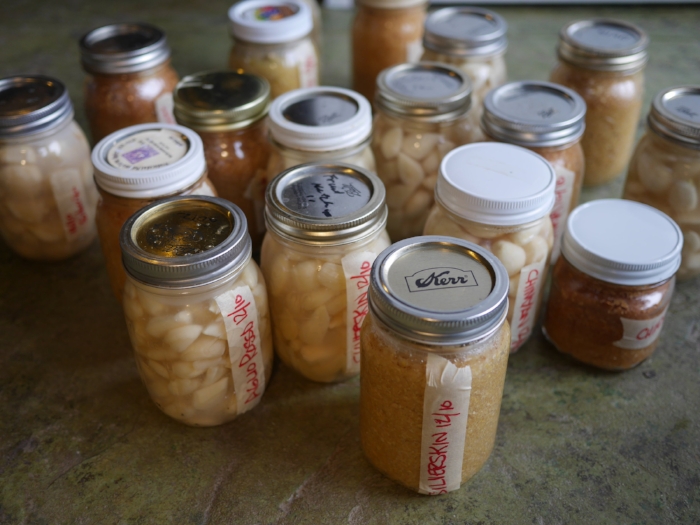Fermented garlic is the ultimate in probiotic convenience food. No, really, if you spend a little time fermenting something you want it to be garlic. Full disclosure: fermenting garlic takes a bit of time—there is all the peeling! Please don’t stop reading though a) its so worth it and b) you’ve got this!
Think about those big jars of minced garlic that are steeped in citric acid that have a flat fresh flavor, not so with fermented garlic paste. This stuff is just as easy in that you can use garlic to your hearts desire at a moments notice. However, there is no comparison on flavor and the added bonus is its live and probiotic. I know, sounding a bit like a used car salesman, but I want you to try lacto fermenting garlic. We are totally addicted to the stuff. One more small advantage to fermented garlic is that in the way it the part of garlic that lingers in your mouth and on your breath. (This has to do with the allicin being an unstable compound, but there are many chemical things at work here.) The important part is you can get away with eating raw garlic without turning everyone away! (Garlic lovers—how cool is that?
This post is to encourage you and to share a recipe for fermented garlic paste, but it is more fun than that. Last fall my farmer friend (and instigator) Mary, brought over 9 types of garlic. She grows seed garlic at Whistling Duck Farm. We did some trials to see how garlic changed with the different varieties. You can see some detailed results on a post I did for Mother Earth News . We used a pound of each variety to ferment in brine as whole clove pickle. And used another pound for fermented garlic paste. We did it all in one day to keep all the factors as even as possible, and for those of you doing the math—that was 18 pounds of garlic peeling!
One of the most fascinating parts of the experiment was seeing the distinguishing characteristics of a fresh variety of garlic might come out totally different when fermented. Fermenting brings out entirely new flavors—even within the same variety the whole clove ferment vs. the fermented paste can be very diverse. The first variance was that the jars all fermented at their own rate. A week in we had an array of colors among the pastes from unchanged to light pink and yellow yet after the fermentation period they all settled on a coppery orange color. Some of the spiciest varieties mellowed out and some of the sweetest varieties took on some heat. The take away, though, is ferment your garlic—all varieties are good! (And for those of you reading this and sad that it is springtime and all the fresh cloves are past you can also ferment the scapes (the flower stem of garlic that is clipped in order to send more energy to the bulb.)
Garlic Paste
Yield: about 1 pint
6–8 heads garlic, cloves separated, peeled, and minced in a food processor
2 teaspoons salt
Process the garlic and the salt to a paste consistency in a food processor. This paste has a sticky, thick gooey consistency. You won’t see a release of brine, in fact you won’t really see a change. Don’t worry—it will work.
Top the ferment with a quart-sized ziplock bag. Press the plastic down onto the top of the ferment, and then fill it with water and seal. This will act as both follower and weight. Set aside out of direct sunlight in a cool spot (55 to 75°F), for 14 to 21 days.
While you monitor this ferment watch for air pockets. While there isn’t much lift action by the CO2 there is some, you will want to press down as needed. We have found that sometimes you can get a bitter, or even chemical flavor which seems to be a result of the trapped CO2 pockets. If you find this has happened stir the paste, press down, and allow it to ferment a few more days. It will right itself. If it still tastes bitter. Again stir the paste, this time place in fridge for a week and the undesirable flavor will dissipate.
Test the ferment on day 14. It's ready when the garlic is milder than when it’s raw, and has a mild acidity.
Tighten the lid and store in the fridge. This ferment will keep refrigerated for a year, though you will use it up much sooner than that.



